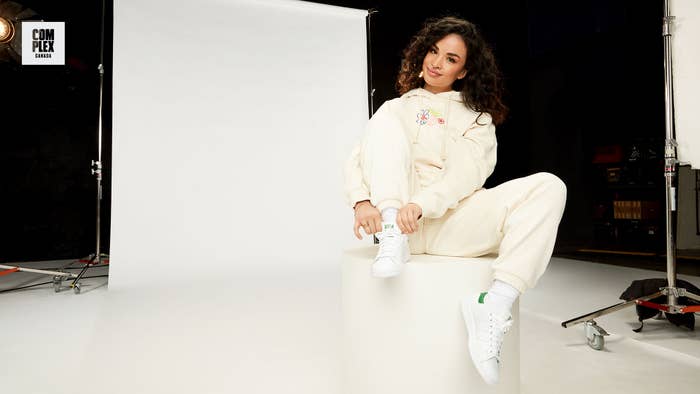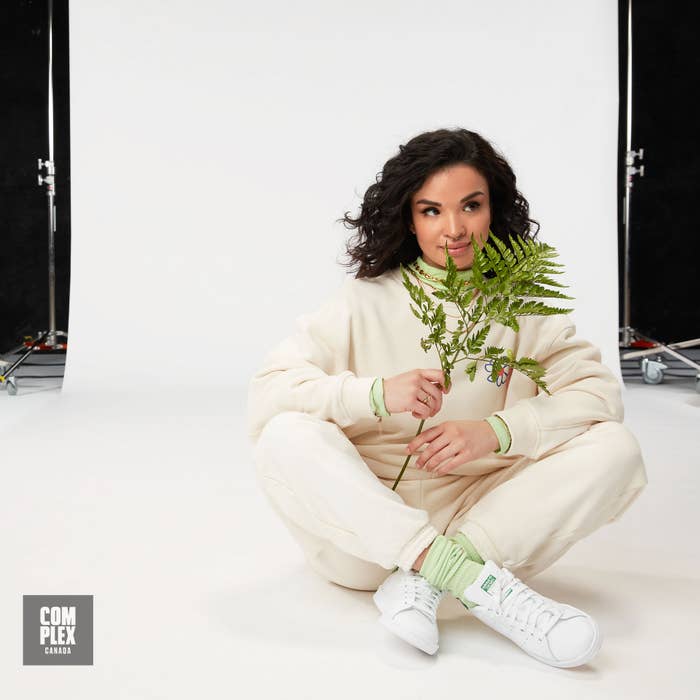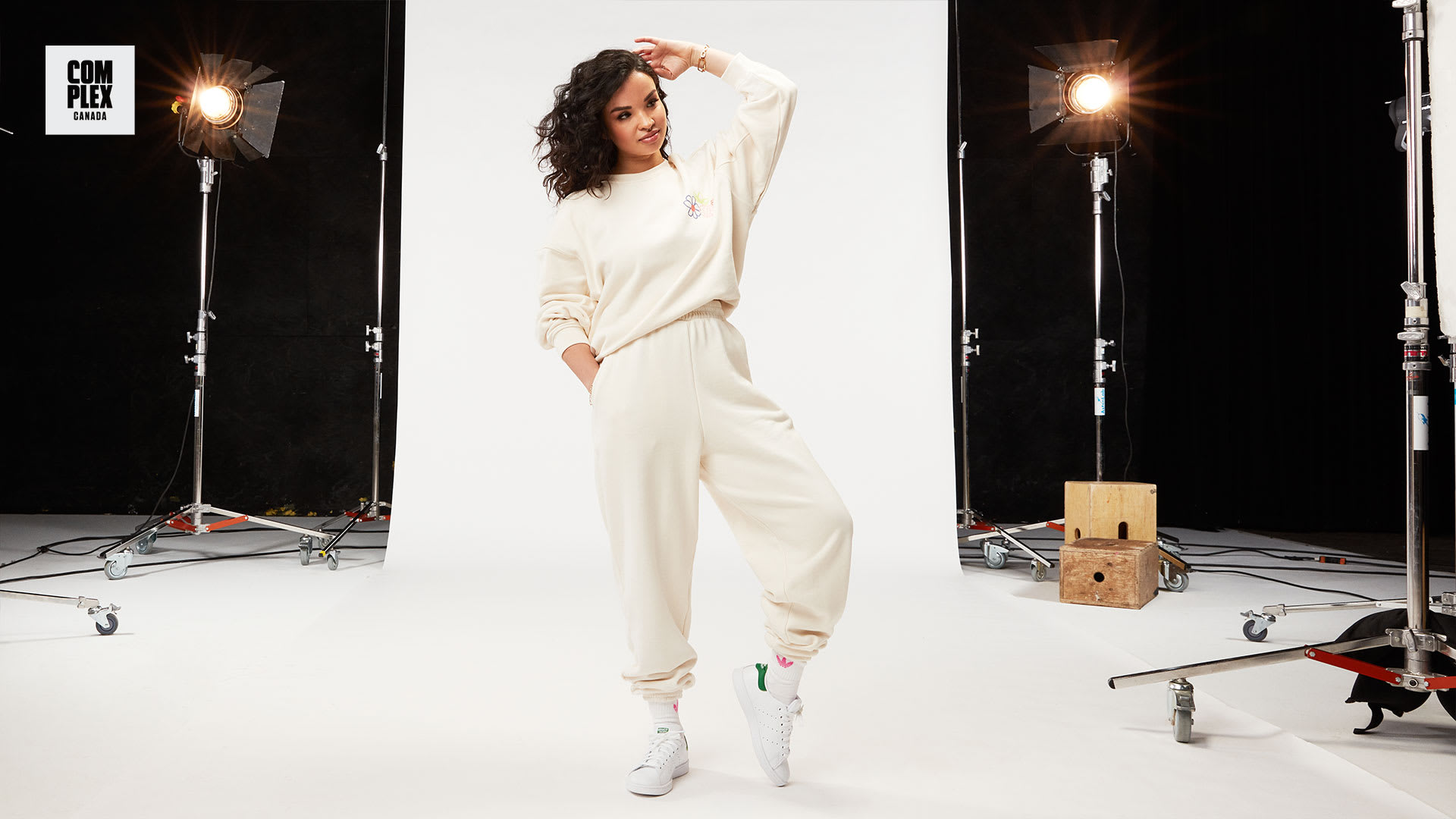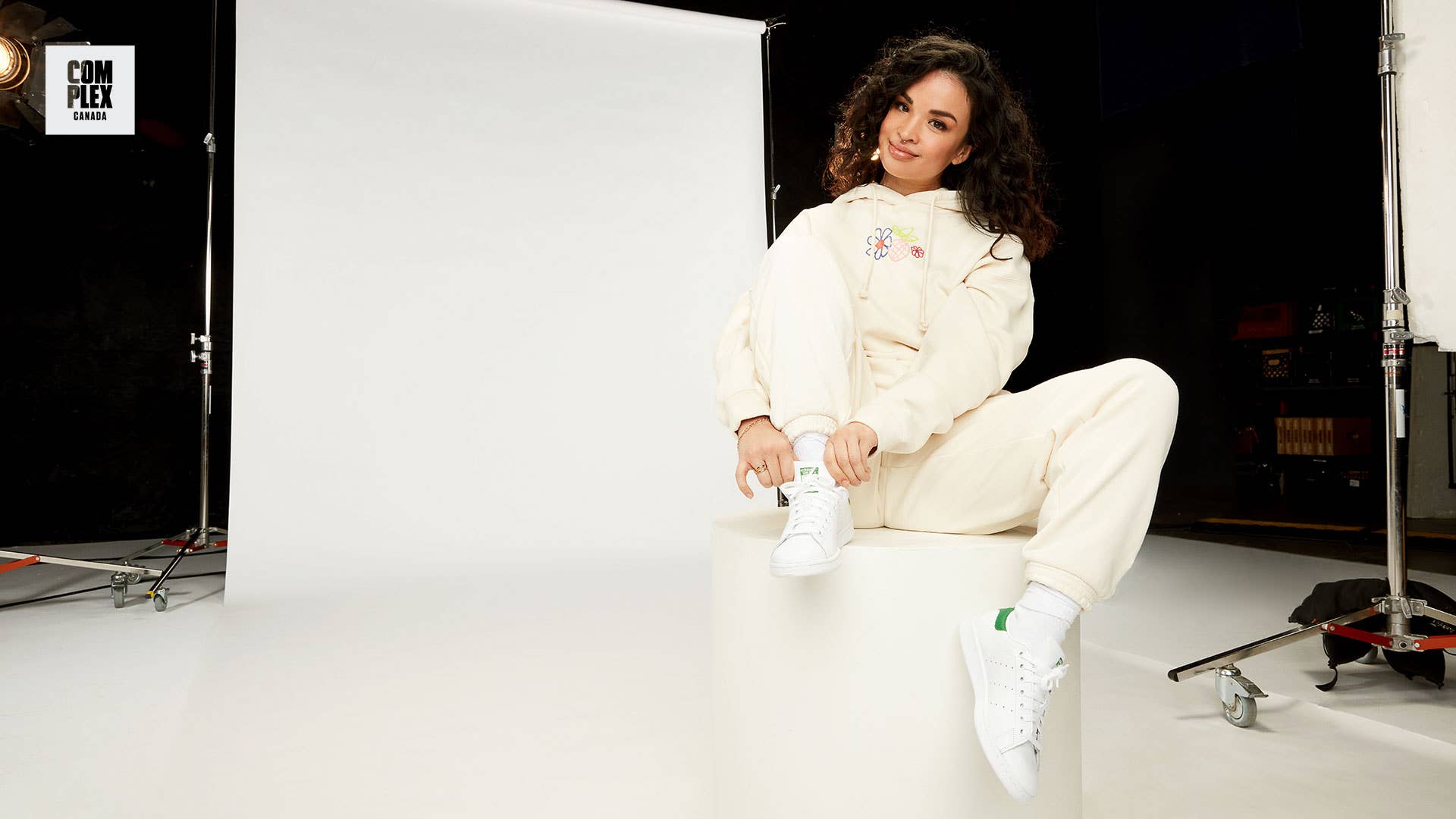
The first thing that comes to mind when you think about adidas probably isn’t a corset—but Toronto’s Natalya Amres isn’t discouraged by your lack of imagination. The queen of DIY cleaves cleats into crazy structural pieces that bring streetwear to the brink of haute couture. Think one-off statement items that include bralettes made from vintage tracksuits, purses carved from basketballs, or clutches hand-stitched from sneakers.
Natalya’s playful designs have been spotted on the party and festival circuit, catching the eye of tastemakers from New York to Seoul. Atlanta’s hottest trap trio the Migos even rocked her upcycled athleisure suits onstage during their tour with Drake a couple years ago. Now, she’s partnering with adidas to showcase their new efforts in sustainability: the footwear titan is shifting operations to only use recycled plastics in their products by 2024 as a move towards more eco-sensible fashion. They’ve hit the ground running with their most sustainable shoe to date: a remix of the iconic Stan Smith classics featuring a white and green colourway.
Catch the latest kicks in our lookbook with Natalya, in which she also rocks a purse she custom-made out of tennis balls. We caught up with our favourite fashionista to chat deconstructive design and what streetwear brands can do to save the planet.

What’s your favourite thing you’ve ever deconstructed? Favourite piece you’ve ever designed?
I think off the top of my head, one of my favourite designs that I made was a bear from this OVO wool blanket. It was a display piece on my couch, and I had been learning how to make bears and wanted to experiment with new materials. I had been really leaning into making 3D pieces and wanted to explore working with materials that would have pretty instant impact—I landed on the blanket because it was pretty nice and expensive. I ended up using 99 percent of the material so it was pretty risky because I literally couldn’t afford to make a bad cut: If I made a bad decision I would have had to throw away the whole bear. I spent three days making it and I got great feedback on it, with someone ultimately choosing to buy it as well. It made me so happy because it could have been a complete disaster but turned out so well, and it showed me that I was still learning more and able to experiment with cool new things and have fun.
How do you see deconstructive design’s role in the sustainability movement? And within the larger global fashion movement overall?
I’ve been a lot more confident about it recently—when I was in school for fashion business, I didn’t know if I could fit into this industry because it was so preppy, structured, and corporate. It discouraged me. I worked in retail for a while, but it’s hard in those positions because it’s so many long hours and you never move up. When I started sewing and people were reacting so well to my pieces, I realized there was this whole other area in the industry, and it’s forcing our brains to reconsider how we manipulate materials. I’m seeing a lot of companies start to upcycle their own product.

What drove you to work with adidas?
Well, adidas is one of those relaxed and comfort-based brands that still manages to have so much playfulness. Even when I was going through my own wardrobe I saw so many matching tracksuits and it just hit me that adidas really gets what I’m going for in my everyday fashion, and the clothes I’m in for them really portray, Holy crap, this is exactly what I would be wearing if I had come up with this!
“When I started sewing and people were reacting so well to my pieces, I realized there was this whole other area in the industry, and it’s forcing our brains to reconsider how we manipulate materials. I’m seeing a lot of companies start to upcycle their own product.”
What are some of the inspiring ways you’ve seen fashion titans take zero waste and sustainability? And why do you think it’s important?
I’ve been keeping tabs on Heron Preston. He started 3D printing shoes. He posts his entire process, and the shoes look really cool. When he makes a mistake, he just grinds down the filament and loads it into the 3D printer to reuse. They’re taking care of the waste within the factory. When I saw that I couldn’t help but think that this is the future.

What drove you to deconstruct footwear? What lessons have you learned about design through disassembling a product?
I went to a sneaker event and they were doing shoe customizations. The shoe I was given was one size too big, so I customized the sole of it. But I couldn’t really wear it because it was too big. I had been dabbling in other materials and always wanted to see what I could do with shoes, so I chose these ones to try cutting into since they were in such perfect condition. I made a little bag out of it! Looking back now, I think it was pretty amateur, but at the time I was so amazed and was considering doing it more often. I ended up using that same template and approach to make other bags, which I sold. I ended up staying on that path, and building up the confidence I needed to keep cutting into this kind of material.
“Sometimes what makes me fearful is cutting into something really sentimental or valuable, or cutting into something really important for a client. But getting to experiment on things I was never going to wear anyway helped me get over that fear.”
And how exactly did you develop that confidence?
Honestly? Just knowing that it can be done. I had attempted to cut through rubber before, so I already had an idea that my tools were good enough to cut through the shoes. The confidence really came from the fact that I knew I wasn’t going to wear the shoes, so I became OK with losing them. Sometimes what makes me fearful is cutting into something really sentimental or valuable, or cutting into something really important for a client. But getting to experiment on things I was never going to wear anyway helped me get over that fear.

What have you learned about design from dissembling footwear?
I definitely learned how to put things back together. At the time, I wasn’t doing any hand stitching and I didn’t really have tools that were strong enough to puncture leather. I ended up using cement glue, which doesn’t work with those materials. I learned a lot about the extra tools I needed to cut through those sneaker materials and handle it well.
I also got a few lessons in being careful in the cutting process. The tools I use are obviously very sharp, so you have to make sure if your hand is in the shoe holding it that you’re not piercing the shoes at the same time. I’ve made mistakes like that before… I definitely want to avoid bloodshed in the future.
Ouch! Did you sustain any gnarly injuries?
Both of my injuries are little ones. The biggest one I got was actually from a rotary cutter: I left it open when I wasn’t using it. I was moving around and my foot grazed it and I didn’t even feel it because it was so sharp, but then I looked down and saw all this blood and was like, “Oh my God… wow.” I definitely felt the pain after I saw it. I definitely learned that when you’re not using the blade—even if it’s just for a minute or two—just close the blade before you go back to it.
Photographer: Katherine Holland
Creative Director: Alex Narvaez
Producer: Mollie Rolfe
Stylist: Shirin Nadjafi
Makeup & Hair: Sherlyn Torres

